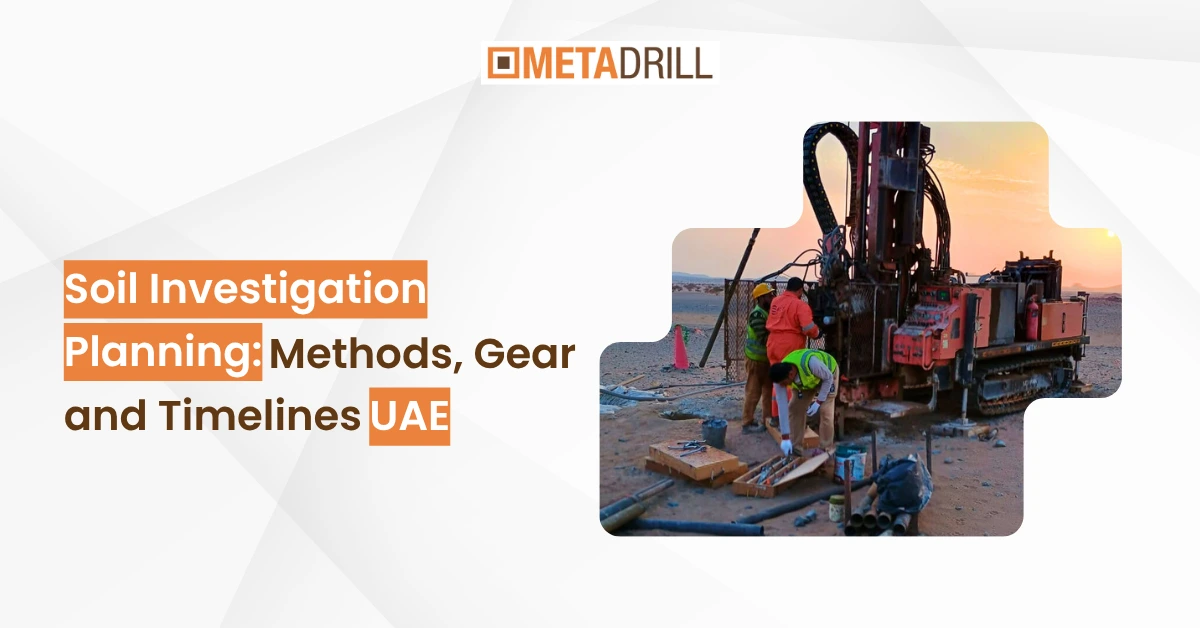
A solid soil investigation plan turns unknown ground into predictable decisions. For UAE projects, align scope, methods, and gear early with your geotechnical drilling company so the team collects the right data, first time. Below is a practical, field-ready guide, planning steps, methods, exploration drill rigs, tooling, and realistic timelines.
“Physical conditions were unforeseen” ranks among the top global dispute causes (16.6%)—a planning gap good SI can reduce.
Plan the Work, Then Work the Plan
Define Purpose, Decision Points, and Deliverables
Before fieldwork, write a one-page intent: what design decisions the Soil investigation must enable (foundation type, depth, dewatering, ground improvement). Tie every test to a decision. Share this with your geotechnical drilling company and designer so drilling, logging, and lab tests ladder up to those decisions.
Standards & Local Governance
Use recognised practice (e.g., BS 5930 / Eurocode 7 concepts) for desk study → reconnaissance → ground investigation → reporting. Dubai authorities require qualified geotechnical engineers to prepare and sign off SI/geo-design. Build these checkpoints into your plan.
Methods That Answer Specific Questions
Core Field Techniques and When to Use Them
Boreholes with sampling & monitoring
Best for: stratigraphy, groundwater, lab specimens.
Notes: pair with standpipes/piezometers for level tracking.
Standard Penetration Test (SPT)
Best for: relative density/consistency in sands/silts; correlations for bearing.
Cone Penetration Test (CPT/CPTu)
Best for: continuous profiling; soft to medium soils; quick density/strength trends.
Geophysics (MASW, seismic refraction, GPR)
Best for: layer continuity, rippability, anomalies before drilling.
Trial pits & plate load
Best for: near-surface conditions, utilities check, bearing at shallow depth.
Tip: Mix methods. Use geophysics to optimise borehole locations, then ground-truth with sampling—this saves time and raises confidence for exploration drilling decisions.
Gear & Tooling: Matching Rig to Program
Choosing exploration drill rigs for UAE Conditions
Urban access / small pads: compact rotary rigs with fast rig-up cut waiting time.
Mixed layers / cemented bands: torque-forward heads and stable feed reduce stalls, protecting the string.
Deep coring: wireline-ready exploration drill rigs give continuous core and quicker recovery cycles for exploration drilling programs.
Drilling rig equipment essentials
Reliable rotation + variable feed: keeps bit on pattern, preserves samples.
Breakout tools & safe rod handling: speed tripping with fewer incidents.
Fluids & recycling: manage fines and minimise mess on tight UAE sites.
Drilling tools that protect data
Bits matched to formation: avoid over-aggressive crowns that fracture core.
Appropriate rods/core barrels: maintain diameter and straightness to keep recovery high.
Clean sampling chain: labelled liners, coolers for temperature-sensitive soils.
Timelines That Survive Reality
From Desk to Report (typical sequence)
Desk Study & Recon (3–7 working days)
Collect prior SI, geology maps, utilities, hydrology, historical uses; walk the site. This phase shapes locations, depths, and the health & safety plan.
Fieldwork (5–15 working days, site-dependent)
Mobilise geotechnical drilling company crew and drill rig.
Drill/test per plan: boreholes, SPT/CPT, install monitoring wells.
Daily logs: strata, N-values, groundwater observations.
Lab Testing (5–15 working days)
Classify soils/rock, index tests (Atterberg limits, moisture), strength/compressibility (triaxial/Oedometer). Calibrate test matrix to design decisions.
Monitoring (parallel or extended)
Groundwater level checks (weekly for 2–4 weeks) if dewatering is likely. Data loggers help on longer programs.
Reporting (5–10 working days)
Drawings, logs, lab tables, cross-sections, geotechnical model, and design parameters with assumptions and limitations. Keep the executive summary decision-focused so non-specialists act fast.
Quality Controls the Team Can Own
Field QC (what to verify daily)
Correct hole IDs, coordinates, and reduced levels.
Sample intervals and recovery; photo core boxes.
SPT energy corrections captured in log notes.
Chain of custody for drilling tools and samples.
Lab & Data QC
Calibrate equipment; verify index/strength test coverage vs. design needs.
Reconcile logs with lab classifications; flag inconsistencies early.
Keep a living risk register—update after each hole for smarter Soil investigation choices.
Quick Decision Matrix (what to escalate)
Escalate to designer immediately if:
Unexpected groundwater inflow threatens excavation.
Refusal hit above expected depth (possible obstruction or harder stratum).
Contamination indicators appear (odour, sheen, PID spikes).
Geophysics suggests anomalies not captured by planned holes.
Why Planning Pays Off
Robust SI underpins schedule and safety. Industry research shows large projects frequently overrun; a classic benchmark found jobs take ~20% longer and run up to 80% over budget, disciplined SI helps de-risk both.
You can also check: Compact Rigs for Tight Sites: Power, Mobility & Productivity
Conclusion
Treat Soil investigation as a decision engine, not a checkbox. Start with purpose, select methods that answer specific questions, and match exploration drilling gear to ground risks. Coordinate early with your geotechnical drilling company so exploration drill rigs, drilling rig equipment, and drilling tools align with design needs and urban constraints. With clear timelines, disciplined QC, and standards-led reporting, your geotechnical drilling company delivers data you can build on—literally.
Share your desk-study findings and target decisions. We’ll map an SI scope that right-sizes methods and timeline for your site.
Question to the public:
UAE soil investigation de-risks projects: align scope with geotechnical drilling company, blend SPT/CPT & core, match rigs, tighten QC to safer builds now.